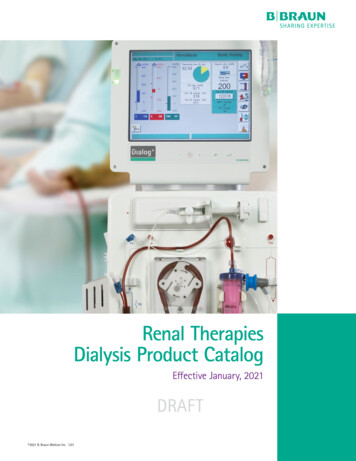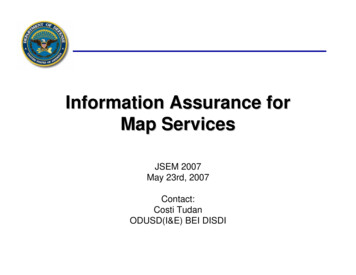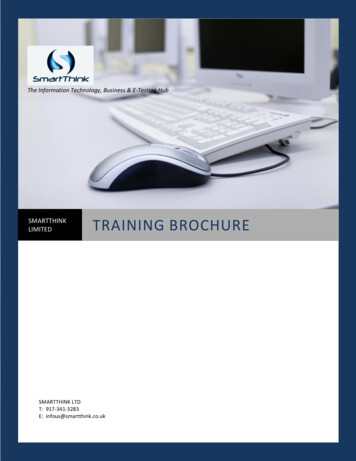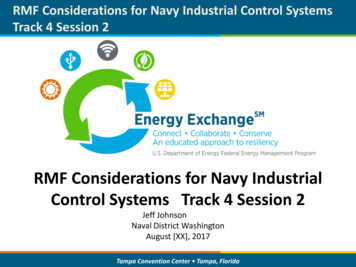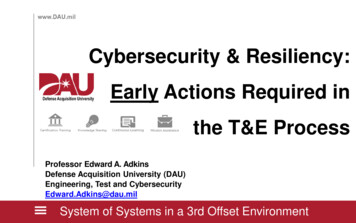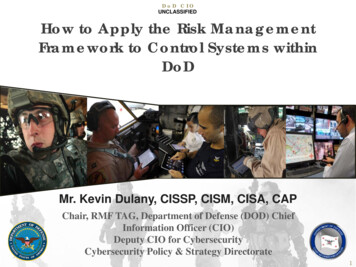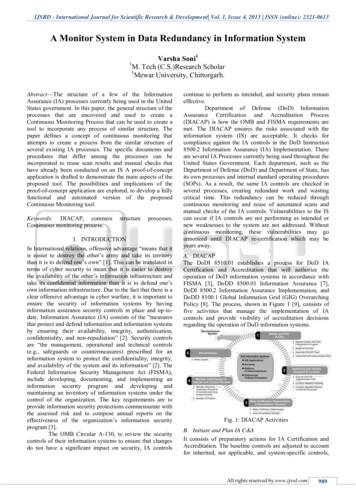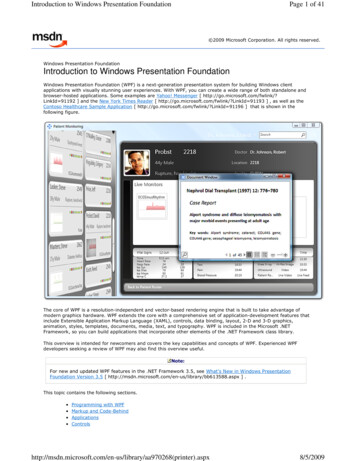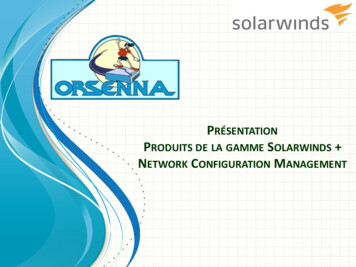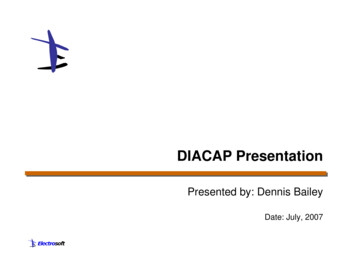
Transcription
DIACAP PresentationPresented by: Dennis BaileyDate: July, 2007
Government C&A Models NIST SP 800-37 - Guide for the Security Certificationand Accreditation of Federal Information Systems NIACAP - National Information Assurance Certificationand Accreditation Process– Based on a process published by the Committee on NationalSecurity Systems (CNSS) documented in the National SecurityTelecommunications and Information System SecurityInstructions,1 otherwise known as NSTISSI No. 1000– Used for C&A of national security systems which are systemsdetermined to be either “Top Secret,” “Secret,” or “Confidential”under Executive order 12958 Electrosoft, 2007
Government C&A Models (continued) DCID 6/3 - Director of Central Intelligence Directive– 6/3 refers to the process described in section 6, part 3 of theDirector of Central Intelligence Directives– For systems that require that anyone working on them to have aTop Secret, Sensitive Compartmentalized Information (SCI)clearance DITSCAP - DoD Information Technology SecurityCertification and Accreditation Process– Introduced in 1997 with 5200.40 directive for DoD systems DIACAP - DoD Information Assurance Certification andAccreditation Process (DIACAP)– Introduced on July 6, 2006 to replace DITSCAP Electrosoft, 2007
Introduction to DITSCAPPhases of DITSCAP (DoD Information Technology SecurityCertification and Accreditation Process) Phase 1 - Definition– SSAA – System Security Authorization Agreement Phase 2 - Verification–––––1. System architecture analysis.2. Software design analysis.3. Network connection rule compliance analysis.4. Integrity analysis of integrated products.5. Life-cycle management analysis. 1. Computer Resource Management Plan (CRMP).2. Computer Resources Life-Cycle Management Plan (CRLCMP).3. Configuration identification procedures.4. Configuration control procedures.5. Configuration status accounting procedures.6. Configuration audit procedures and reports.7. Software engineering (development approach and engineering environment) procedures.8. Trusted distribution plans.9. Contingency, continuity of operations, and back-up plans.– 6. Vulnerability assessment. Electrosoft, 2007
Introduction to DITSCAP (Continued) Validation––––––––1. Security Test and Evaluation.2. Penetration testing.3. TEMPEST and Red-Black verification.4. Validation of COMSEC compliance.5. System management analysis.6. Site accreditation survey.7. Contingency plan evaluation.8. Risk-based management review. Post-Accreditation Electrosoft, 2007
Introduction to DIACAP DIACAP is the Department of Defense InformationAssurance Certification and Accreditation Process. It was introduced by a Defense Department directive onJuly 6, 2006. Interim guidance was issued and the official 8510.bbdocument is waiting to be signed. Replaces DITSCAP, the C&A process since 1997. Regulatory policy is based on the 8500 seriesdocuments and FISMA. Transition requirements – 180 days to prepare a planand accreditation before 3 year expiration of DITSCAPC&A. Electrosoft, 2007
Background on DIACAP DoD wanted to modernize their IA programs with thefollowing goals in mind:– Streamline C&A processes– Compatibility with DoD's vision of net-centric operations and theGlobal Information Grid (GIG)– Compliance with the Federal Information Security ManagementAct of 2002 (FISMA)– Utilization of a C&A solution that considers shared risks Electrosoft, 2007
Net-Centric Data are visible, accessible and understandable whenand where needed to accelerate decision making Tagging of all data with meta data to enable discovery byusers All data is posted to shared spaces for users to accessexcept when limited by security, policy or regulations. Emphasis on many-to-many sharing between COIs(Communities of Interest) A philosophy of enabling information sharing across theGIG (Global Information Grid) Electrosoft, 2007
Global Information Grid (GIG) Seamless and secure end-to-end IA architecture utilizingshared services Less focus on individual systems and more on enclaves Empowers the user with ability to access all relevant infoand recognizes user as an information source Supports formation of dynamic communities of interest(COIs) Shift in approach from need to know to need to share Electrosoft, 2007
C&A on the GIG DIACAP supports the GIG through:– Focused on assurance for shared systems and not stove-pipedsystems.– Inheritance – the sharing of security controls, validation resultsand C&A status across systems and networks.– Putting C&A information for every system online and using thatinformation as a part of accreditation decisions.– Takes accreditation decisions to the component and missionlevel. Electrosoft, 2007
Components The DIACAP program is composed of three parts:– DIACAP Knowledge Service (KS)– Enterprise Mission Assurance Support Service (eMass)– C&A Processes Electrosoft, 2007
DIACAP Knowledge Service (KS) Tools such as current C&A guidelines, diagrams,process maps and documents Community forum to interact with users Implementation guidance and assessment proceduresfor each control Electrosoft, 2007
Enterprise Mission AssuranceSupport Services (eMass) Systems are registered using a System IdentificationProfile (SIP) Creates a C&A package for the management of eachregistered system Includes workflow and scheduling of activities Assignment and tracking of controls PKI used to audit transactions Scalable to any enterprise Developed by BAH Electrosoft, 2007
C&A Process The DIACAP process is composed of five phases: Electrosoft, 2007
Roles & Responsibilities Designated Accrediting Authority (DAA) Program or System Manager (PM or SM) Information Assurance Managers (IAM) Certifying Authority (CA) Principal Accrediting Authority (PAA) Senior Information Assurance Officer (SIAO) User Representative (UR) Electrosoft, 2007
System Identification Profile (SIP) Formal System Registration Describes Mission and System Specifies DIACAP Team Determination of Mission Assurance Categories andConfidentiality Level Electrosoft, 2007
Mission Assurance Categories(MACs) Reflects the importance of information relative to the achievement ofDoD goals and objectives, especially concerning combat missions.– MAC I: Information that is determined to be vital to the operationreadiness or mission effectiveness of deployed and contingency forcesin terms of both content and timeliness– MAC II: Information that is important to the support of deployed andcontingency forces.– MAC III: Information that is necessary for the conduct of day-to-daybusiness, but does not materially affect support to deployed orcontingency forces in the short term Electrosoft, 2007
Mission Assurance Categories(MACs) Each MAC level has required levels of integrity andavailability– MAC I - High Integrity, High Availability– MAC II - High Integrity, Medium Availability– MAC III - Basic Integrity, Basic Availability Electrosoft, 2007
Confidentiality Level (CL) The Confidentiality Level (CL) measures a system'sconfidentiality requirements based on whether thesystem processes classified, sensitive or publicinformation.– Classified– Sensitive– Public Electrosoft, 2007
Baseline Assurance Levels The nine combinations of MAC and CL establish nine baseline IAlevels within the GIG Electrosoft, 2007
IA Control Subject Areas DoD 8500.2 (Information Assurance Implementation)Enclosure 4––––––––DC - Security Design & ConfigurationIA - Identification and AuthenticationEC - Enclave & Computing EnvironmentEB - Enclave Boundary DefensePE - Physical & EnvironmentalPR - PersonalCO - ContinuityVI - Vulnerability & Incident Management Electrosoft, 2007
Minimum Score Each system has to get a required minimum number of points inthe IA categories of Confidentiality, Availability and Integrity Electrosoft, 2007
Scorecard The Scorecard shows the certification andaccreditation status of a system in a concise format––––Specific Controls RequiredNumber of Compliant/Non-compliant AreasAssessed Risk Status of Each Non-compliant areaAccreditation decision Electrosoft, 2007
Accreditation Package System Identification Profile–––––– Implementation PlanIA Controls – Inherited and implementedImplementation StatusResponsible entitiesResourcesEstimated completion date for each IA ControlSupporting Documentation for Certification– Actual Validation Results– Artifacts associated with implementation of IA Controls DIACAP Scorecard– Certification determination– Accreditation Determination POA&M (If required) Electrosoft, 2007
Accreditation Decisions Authorization to Operate (ATO) – 3 years with annualreviews. Interim Authorization to Operate (IATO) – 180 days, nomore than 2 in a row. Interim Authorization to Test (IATT) – Special testing ofoperational system or with live data. Denial of Authorization to Operate (DATO) - POA&Mrequired to address issues. Electrosoft, 2007
Introduction to DIACAP DIACAP is the Department of Defense Information Assurance Certification and Accreditation Process. It was introduced by a Defense Department directive on July 6, 2006. Interim guidance was issued and the official 8510.bb document is waiting to be signed. Replaces DITSCAP, the C&A process since 1997.
